Dental wax is a handy product often recommended by dentists and orthodontists to alleviate discomfort and irritation caused by braces, wires, or other dental appliances. While dental wax is effective, there may be situations where you find yourself in need of an alternative. Whether you’ve run out of wax or are looking for different options, this comprehensive guide will explore various alternatives to dental wax, how to use them safely, and essential tips for managing orthodontic discomfort.
Understanding the Purpose of Dental Wax
Before delving into alternatives, let’s first understand why dental wax is commonly used:
Pain Relief: Dental wax provides a protective barrier between braces or wires and the soft tissues of your mouth, including your cheeks, lips, and tongue. This barrier helps reduce friction and irritation, offering relief from pain or discomfort.
Prevention of Sores: Orthodontic appliances can sometimes cause sores or ulcers due to constant contact with the delicate oral tissues. Dental wax acts as a cushion, preventing these painful sores from forming.
Emergency Repairs: Dental wax can also be used for temporary emergency repairs, such as securing a loose wire or bracket until you can see your orthodontist.
Alternatives to Dental Wax
While dental wax is widely available and effective, there are alternative products and methods that can provide relief in situations where wax is not accessible or practical. Here are some alternatives to consider:
1. Silicone Orthodontic Relief
Silicone-based orthodontic relief products are designed specifically to provide comfort for individuals with braces. These products come in various forms, including silicone strips and pads. They are easy to apply and provide a smooth, cushioned barrier between your braces and oral tissues.
2. Orthodontic Lip Bumper
An orthodontic lip bumper is a soft, silicone device that covers the braces’ wires and brackets. It’s designed to protect your lips from irritation and can be especially helpful if you’re experiencing sore spots.
3. Dental Silicone
Dental silicone, similar to silicone orthodontic relief products, can be used as a temporary alternative to dental wax. It’s a soft, pliable material that can be molded and applied to the sharp edges of braces or wires for added comfort.
4. Orthodontic Relief Wax Alternatives
Some orthodontic companies offer wax alternatives specifically designed for comfort and relief. These alternatives are often made of silicone or similar materials and can provide a soothing barrier between your braces and mouth.
5. Orthodontic Lip Protectors
Orthodontic lip protectors are silicone shields that fit over the braces and wires. They create a protective cushion around your braces, reducing friction and irritation on your lips and cheeks.
Tips for Using Alternatives Safely
When using alternatives to dental wax, it’s important to do so safely to avoid any complications or discomfort:
Follow Instructions: Always follow the manufacturer’s instructions when using any orthodontic relief product, including alternatives to dental wax.
Cleanliness: Ensure that your hands and the area around your braces are clean before applying any product. This helps prevent contamination and maintains good oral hygiene.
Proper Fit: Ensure that the alternative product fits comfortably and does not impede the movement of your braces or wires.
Regular Check-Ups: Continue with your regular orthodontic check-ups, and inform your orthodontist if you’re using an alternative to dental wax.
Keep Hydrated: Staying well-hydrated can help reduce friction and irritation caused by braces, making alternatives more effective.
Emergency Repairs: For emergency repairs, consult your orthodontist as soon as possible. Alternatives can provide temporary relief but should not replace professional dental care.
Orthodontist’s Advice: If you’re unsure about which alternative product to use or how to use it effectively, consult your orthodontist for guidance.
Conclusion
Dental wax is a tried-and-true solution for managing discomfort and irritation caused by braces, wires, or other dental appliances. However, there are alternatives available that can provide relief in situations where dental wax may not be an option. When choosing an alternative, consider factors such as comfort, safety, and ease of use. Regardless of the product or method you choose, it’s essential to prioritize your oral health and hygiene throughout your orthodontic journey. If you have any concerns or questions, consult your orthodontist for personalized guidance and recommendations. With the right approach, you can effectively manage orthodontic discomfort and continue on your path to a healthy, beautiful smile.
Related Topics:






























